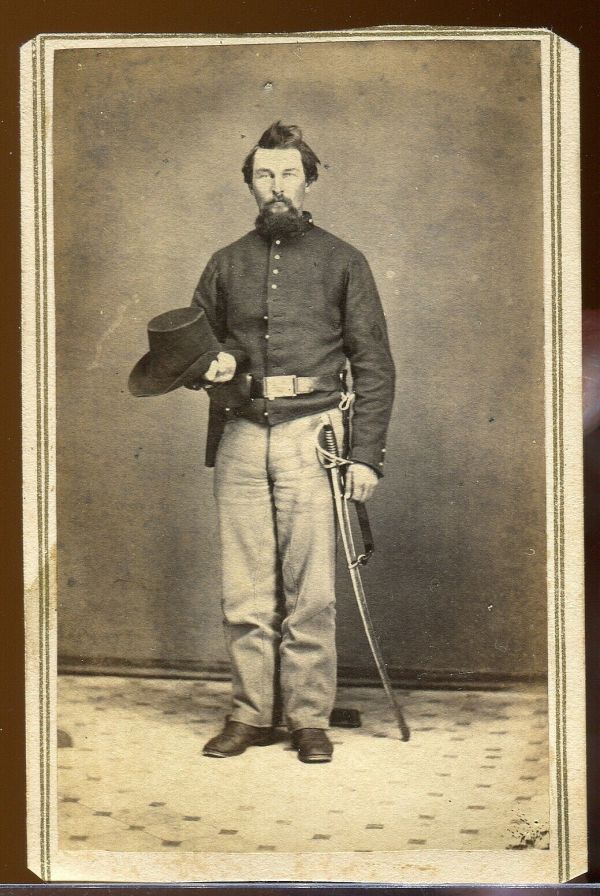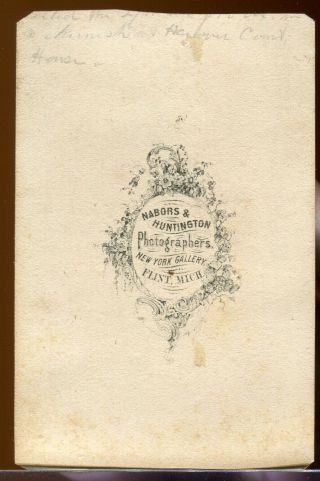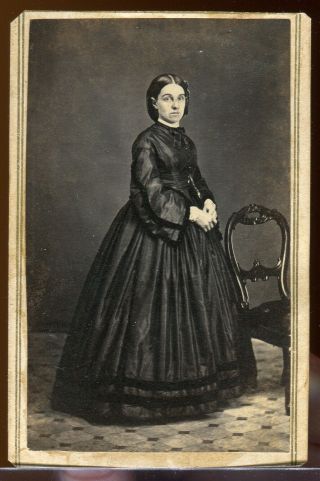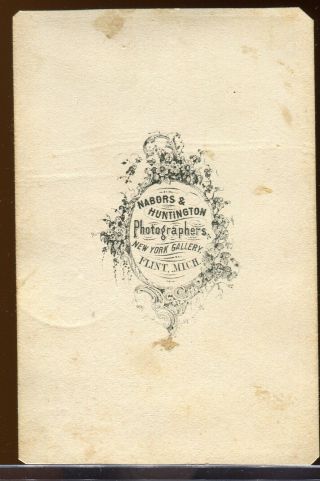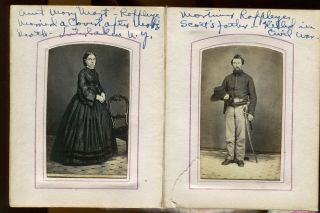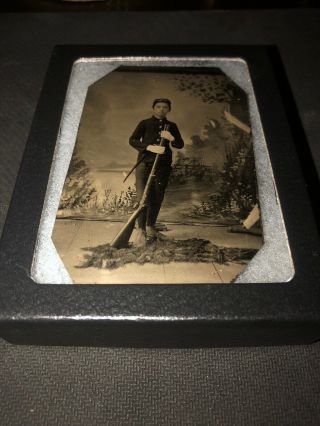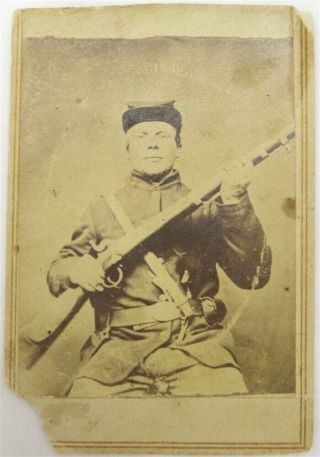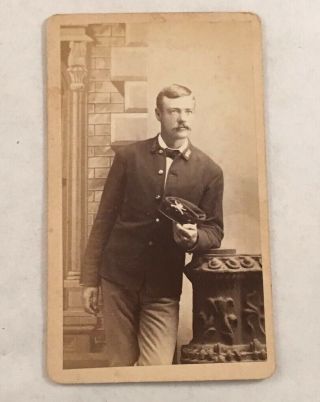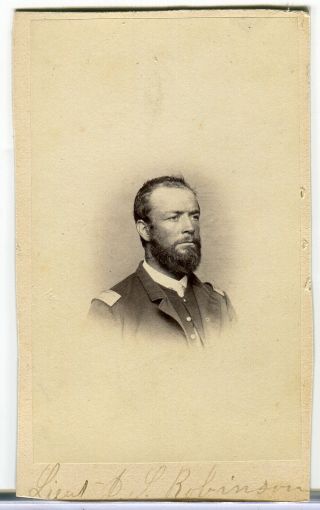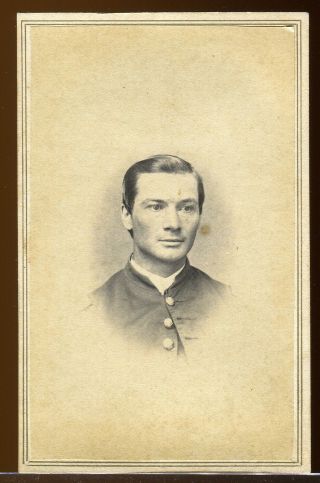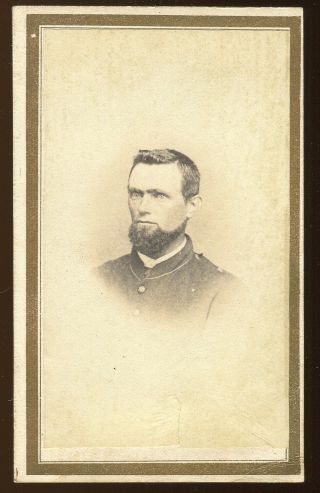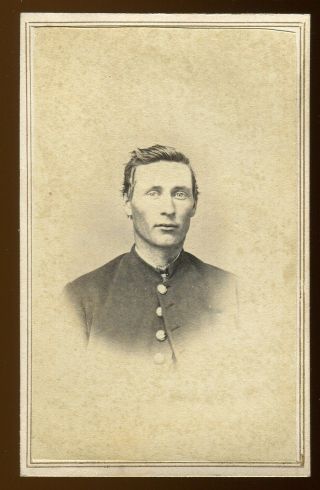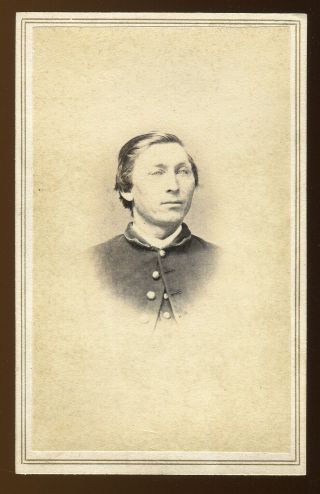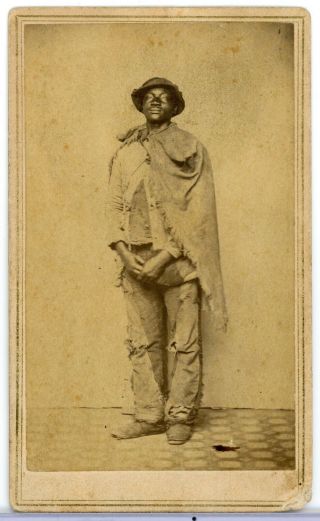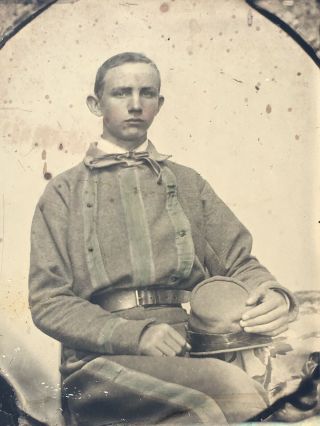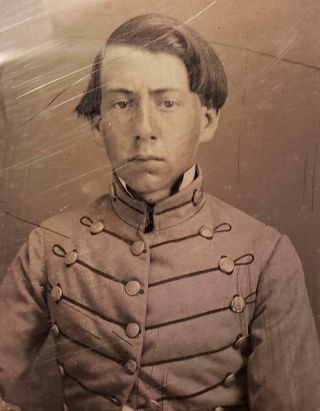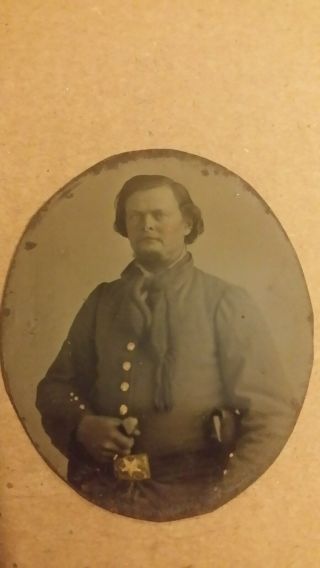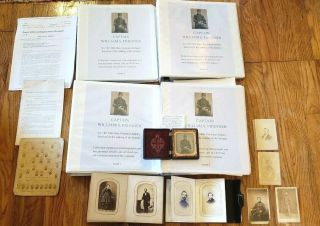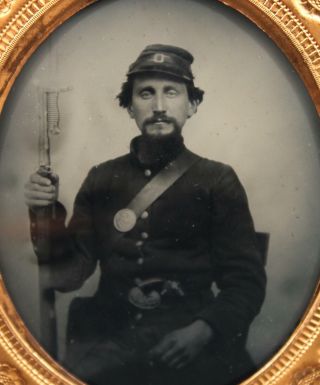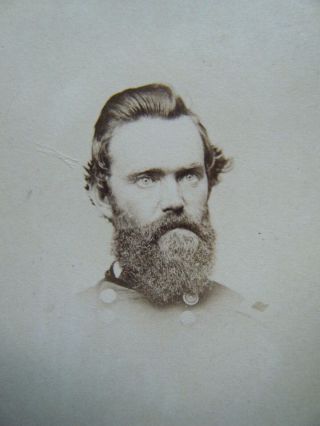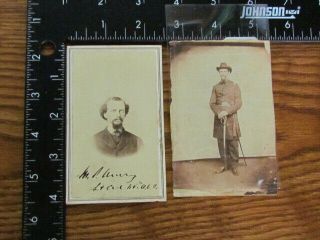CDV PHOTOGRAPH CIVIL WAR ARMED SOLDIER 6TH MICHIGAN CAVALRY BRIGADE KIA
Item History & Price
| Reference Number: Avaluer:53414809 | Modified Item: No |
| Original/Reproduction: Original | Country/Region of Manufacture: United States |
| Conflict: Civil War (1861-65) | Theme: Militaria |
Mortimer Y. Rappelye
Residence Flint MI; 31 years old.Enlisted on 9/1/1862 at Grand Rapids, MI as a Qtr Master Serg.On 10/11/1862 he mustered into "C" Co. MI 6th Cavalry He was Killed on 5/27/1864 at Hanover Town, VAPromotions:* 1st Sergt 9/1/1863 Other Information:born in 1830Buried: Lakeview Cemetery, Interlake, NY
Sixth Cavalry.
(Three Years)
The Sixth Regiment of Michigan Volunteer Cavalry was organized in the summer of 1862, under authority of the Secretary of War, granted directly to Hon. Francis W. Kellogg, member of Congress from the (then) Fourth Congressional District of Michigan. It comprised twelve troops of a maximum strength of 100 men each, including the proper complement of non-commissioned officers. The rendezvous was Grand Rapids. George Gray, a leading lawyer of the state, was commissioned Lieutenant Colonel and assigned to command of the camp. Troop commanders were ordered to report to him. Subsequently, and before the date of muster, Governor Blair, in compliance with a petition of the officers of the regiment, commissioned him as Colonel. Major Russell A. Alger of the Second Michigan Cavalry, was commissioned to succeed Colonel Gray as Lieutenant Colonel. The regiment was mustered into the United States service October 11, 1862, with 1229 officers and men. But four of the officers had seen service, viz: Lieutenant Colonel R. A. Alger, previously Captain and Major of the Second Michigan Cavalry; Captain Peter A. Weber, in the Third Michigan Infantry, and Battalion Adjutant of the Second Michigan Cavalry; Lieutenant Don G. Lovell, as Corporal in the Third Infantry, and Lieutenant Phineas G. White, as Sergeant in the First Michigan Cavalry. The following were the original officers of the regiment: FIELD AND STAFF. Colonel, George Gray; Lieutenant Colonel, Russell A. Alger; Majors, Thaddeus Foote, Elijah D. Waters and Simeon B. Brown; Surgeon, Daniel G. Weare; Assistant Surgeon, David C. Spaulding; Adjutant, Hiram F. Hale; Quartermaster, Charles H. Patten; Commissary, Jacob Chapman; Chaplain, Stephen S. S. N. Greeley. TROOP OFFICERS. A. Captain, Henry E. Thompson, Grand Rapids. First Lieutenant, Manning D. Birge, Grand Rapids. Second Lieutenant, Stephen H. Ballard, Grand Rapids. Second Lieutenant, Joel S. Sheldon, Grand Rapids. B. Captain, Peter A. Weber, Grand Rapids. First Lieutenant, Warren C. Comstock, Grand Rapids. Second Lieutenant, Charles E. Bolza, Grand Rapids. Second Lieutenant, Charles E. Storrs, Blendon. C. Captain, Wesley Armstrong, Lapeer. First Lieutenant, Edward Potter, Burchville. Second Lieutenant, William Creevy, Lexington. Second Lieutenant, George S. West, Lexington. D. Captain, David G. Royce, Burns. First Lieutenant, Seymour Shipman, New Haven. Second Lieutenant, Horace B. Rogers, Lansing. Second Lieutenant, Schuyler F. Seager, Lansing. E. Captain, James H. Kidd, Ionia. First Lieutenant, Edward L. Craw, Lyons. Second Lieutenant, Franklin P. Nichols, Ionia. Second Lieutenant, Ambrose L. Soule, Lyons. F. Captain, William Hyser, Plainfield. First Lieutenant, Don C. Batchelder, Ypsilanti. Second Lieutenant, Don G. Lovell, Grand Rapids. Second Lieutenant, George W. Crawford, Plainfield. G. Captain, George A. Drew, Detroit. First Lieutenant, Harrison L. Throop, Owosso. Second Lieutenant, William Hull, Detroit. Second Lieutenant, Phineas G. White, Lapeer. H. Captain, Henry L. Wise, Caledonia. First Lieutenant, James H. Lobdell, Muskegon. Second Lieutenant, Horace H. Richards, Paris. Second Lieutenant, James H. Kellogg, Grand Rapids. I. Captain, Charles W. Deane, Pentwater. First Lieutenant, Robert A. Moon, Big Rapids. Second Lieutenant, John S. Joslyn, Holly. Second Lieutenant, Malcom M. Moore, Grand Rapids. K. Captain, John F. Andrews, Thornapple. First Lieutenant, Peter Cramer, Woodland. Second Lieutenant, Lewis H. Jordan, Irving. Second Lieutenant, Caleb W. Robinson, Grand Rapids. L. Captain, John Torry, Saginaw. First Lieutenant, Philip G. Corey, Galesburg. Second Lieutenant, James Mather, Pavilion. Second Lieutenant, Elliot F. Covell, Grand Rapids. M. Captain, John M. Pratt, Saranac. First Lieutenant, Harvey H. Vinton, Vergennes. Second Lieutenant, Benjamin F. Rockafellow, Lyons. Second Lieutenant, Elias B. Stone, Bowne. The following held positions in the field, staff and non-commissioned staff during the history of the regiment: Colonels--George Gray, James H. Kidd. Lieutenant Colonels--Russell A. Alger, Thaddeus Foote, Henry E. Thompson, George A. Drew and Harvey H. Vinton. Majors--Thaddeus Foote, Elijah D. Waters, Simeon B. Brown, Peter A. Weber, James H. Kidd, George A. Drew, Charles W. Deane, Harvey H. Vinton, Manning D. Birge, Charles E. Storrs, Don G. Lovell. Surgeon--Daniel G. Weare. Assistant Surgeons--David C. Spaulding, James Sleeth, Henry Johnson. Adjutants--Hiram F. Hale, Aaron Cone Jewett, Henry V. Hobart, Elliott M. Norton. Quartermasters--Charles H. Patten, William H. Jewell. Commissaries--Jacob Chapman, Joel S. Sheldon, George W. Simonds. Sergeant Majors--Henry V. Hobart, Elliott M. Norton, Sessions P. Curtiss, William Keyes. Quartermaster Sergeants--Oliver N. Taylor, William H. Jewell, John H. Dickey. Commissary Sergeants--James H. Dudley, Perley W. Johnson. Hospital Stewards--John G. Havens, Edwin R. Cobb, Benjamin R. Rose, Miles H. Seeley. Chief Bugler--Thomas Shaw. Veterinary Surgeons--Ira C. Horton, Orson N. Earll. Farrier--Gilbert G. Bailey. Saddler Sergeants--James Somerville, John Pollock. Lieutenant Colonel Alger was promoted to Colonel of the Fifth Michigan Cavalry. Lieutenant Colonel Thaddeus Foote to Colonel of the Tenth Michigan Cavalry. Major Simeon B. Brown to Colonel of the Eleventh Michigan Cavalry. Major Weber was killed at Falling Waters, Md., July 14, 1863; Adjutant Jewett at Williamsport, Md., July 6, 1863. Major Drew served on the staff of General Custer during the war, as did Captain L. W. Barnhart. Lieutenant White was on the staff of General Copeland. Captain Probasco and Lieutenant Hull served on the brigade staff, the latter on staff of Colonel Charles R. Lowell. Sergeant Dudley was given a commission in a United States colored regiment. Lieutenant Seager and Adjutant Hale became U. S. Paymasters. Captains Wise and Armstrong became Majors in the Eleventh Michigan Cavalry. Sergeant C. W. Watkins became a Captain in the Tenth Michigan Cavalry. Before leaving Grand Rapids in December the regiment was mounted and each troop had horses of one color--A, bays; B, browns; C, greys; D, blacks; L, sorrels, etc. After arriving in Washington it was armed with Spencer repeating rifles, sabers and revolvers. Later on, the rifles were exchanged for carbines, a lighter arm of the same caliber. On the 10th of December, 1862, the regiment proceeded to Washington, D. C., and went into camp on "Meridian Hill, " between Fourteenth and Seventh streets. While there it was brigaded with the Fifth and Seventh, under Brigadier General J. T. Copeland, formerly Colonel of the Fifth. The brigade was attached to Casey's division of Heintzelman's corps, Department of Washington. During the winter it participated in two raids across Long Bridge into Virginia, in one of which it rode with Sir Percy Wyndham to Falmouth, where Burnside's army was in camp. No enemy except a few guerrillas was encountered. In the spring it broke camp in Washington and marched to Fairfax Court House and was kept on picket until June. Six troops under Lieutenant Colonel Alger were sent to the vicinity of Vienna and maintained a line of videttes along Difficult Creek from where it empties into the Potomac River. Two troops, I and M, had been sent on detached duty in the lower Shenandoah Valley, where they remained until the spring of 1864, when they rejoined the regiment at Culpepper, Va. The others were under Colonel Gray maintaining a part of the cordon of videttes which surrounded Washington. Copeland's brigade, the First Michigan Cavalry having been attached, was a part of Stahel's division of cavalry. When Hooker's army began its movement into Maryland to head off Lee, Stahel's division was made a part of the army of the Potomac, and the Sixth Michigan acted as rear guard at the crossing of the Potomac River at Edward's Ferry. Kilpatrick succeeded Stahel; and Custer, promoted to Brigadier General from the rank of Captain on Pleasanton's Staff, took the place of Copeland. He was first seen by the Michigan men at the battle of Hanover, Pa., June 30, 1863, the first time the Sixth was under fire. The regiment, to quote General Kilpatrick's report, "particularly distinguished" itself at Hunterstown after dark on July 2, where it encountered Wade Hampton's cavalry. It was in the famous cavalry fight on the right at Gettysburg, July 3, where it supported Pennington's battery. It marched all day July 4 in a pouring rain, was in the engagement in the mountain pass at Monterey at midnight, July 4; was at Smithfield, Boonsboro, Hagerstown, Williamsport (July 6), where Adjutant Jewett was killed, and at Falling Waters, July 14, where, under Major Weber, who was killed, it attacked the rear guard of the army of northern Virginia, under General Pettigrew, who was also killed, making a charge which Kilpatrick in his official report referred to as "the most gallant ever made, " and which a confederate writer in a southern paper afterwards described as "a charge of dare-devils." With one exception, Hawes' Shop, this was the most sanguinary engagement in which the Sixth ever took part. The regiment followed Custer in all the cavalry engagements which followed in Virginia. It performed conspicuous service at Brandy Station, Oct. 11, and at Buckland Mills, Oct. 19, 1863. It was at Mine Run, Morton's Ford, Raccoon and Summerville Fords and other minor engagements, and went into winter quarters at Stevensburg, Va. During that year it was a part of the Second Brigade, Third Division, Cavalry Corps. It remained at Stevensburg all winter, commanded for the most part by Lieutenant Colonel H. E. Thompson, except that in the latter part of February, 1864, two hundred picked men of the regiment, under command of Major Kidd, went on the ill-fated "Kilpatrick raid" to Richmond. It brought up the rear when Kilpatrick was driven out of his camps near Meadow Bridge, at midnight, by a force which came out of Richmond for that purpose. It marched down the peninsula to Norfolk and, embarking on transports at Yorktown, came back via Washington to its camps near Culpepper. The brigade was then transferred and became the First Brigade, First Division, Cavalry Corps, a designation which it retained till the war closed. On the 6th of May, 1864, the Sixth was hotly engaged on the left of Hancock's corps in the Wilderness. It succeeded, however, in routing the enemy to which it was opposed (Rosser's cavalry), who retreated, leaving their dead and wounded in our hands. The Sixth led the advance on the first day (May 8) of Sheridan's great raid, when ten thousand cavalrymen marched in column of fours, in a single column; was at Beaver Dam Station, at Yellow Tavern (where Stuart, the confederate leader, was killed), at Hanovertown, at Hawes' Shop, at Cold Harbor, at Trevillian Station, Meadow Bridge and many other engagements during the months of May and June. It accompanied Sheridan to the Shenandoah Valley and was in the battles of Winchester, Tom's Brook, Luray, Shepardstown and Cedar Creek. The service which the regiment performed was always creditable. If any engagements were to be singled out in which its gallantry was more conspicuous than at other times we should say: Hunterstown, Falling Waters, Monterey Gap, Buckland Mills, Brandy Station, Kilpatrick Raid, Wilderness, Yellow Tavern, Hawes' Shop, Cold Harbor, Hanovertown, Winchester, Shepardstown, Tom's Brook and Cedar Creek. In the spring of 1865 the regiment left Winchester with Sheridan and did excellent service in the closing campaign of the war, from Winchester to Appomattox. It marched to Washington, participated in the Grand Review and was then ordered to Leavenworth, Kan., whence it marched 1100 miles via Fort Kearney, Julesburg and Fort Laramie to Powder River, Wyoming Territory, a portion of it, under Major Lovell, going still farther to the Rosebud country. Four troops formed a part of the Powder River Indian expedition, and built a fort on that river about 50 miles from where it empties into the Yellowstone. The men who had less than two years to serve were ordered back to the states and were mustered out at Jackson, Mich., in November, 1865. The others were consolidated into a new regiment and sent to Utah.
Condition: Very Good. Please see our large scans for an accurate representation of the image. Shipping in the the USA $3.00. Insurance for overseas will be calculated according to destination. As always satisfaction guaranteed.PLEASE SEE OUR OTHER AUCTIONS FOR MORE INTERESTING ANTIQUES THIS WEEK!
01104



